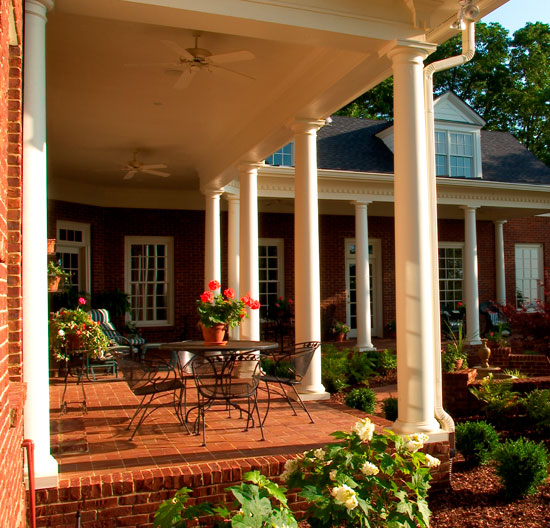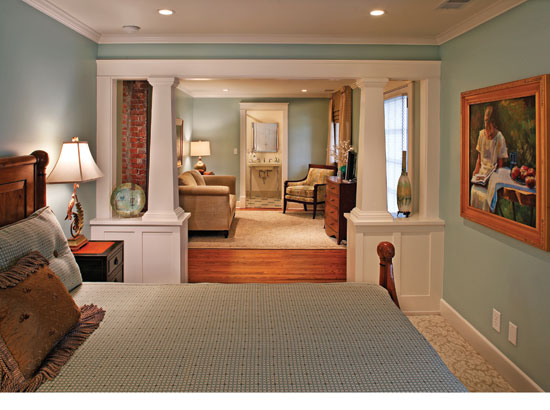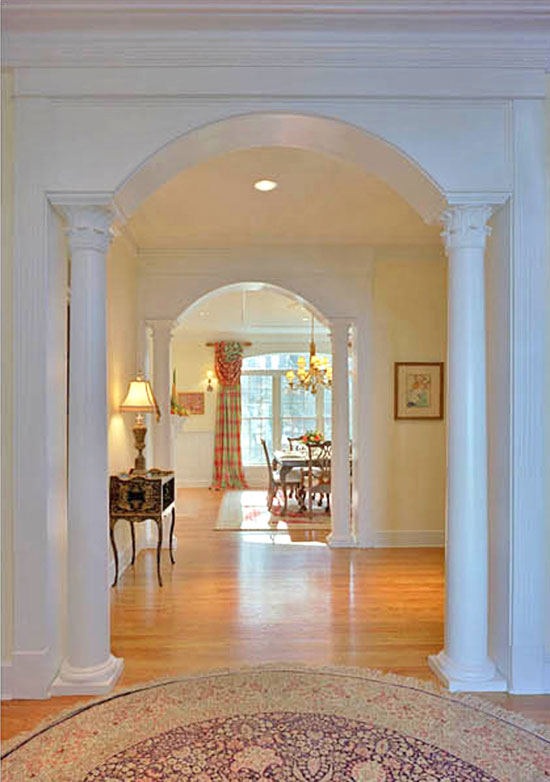Architectural Columns: Classic to Current
Fiberglass
For the majority of columns in buildings today, specially formulated fiberglass polymers are the most practical and flexible options. Cast fiberglass columns are composed of varying amounts of polymers reinforced with fine fibers of glass (FRP or Fiber Reinforced Polymers). Durability in a column is proportional to the amount of fiberglass used. Some manufacturers, for example, use as much as 40 percent fiberglass for enhanced durability. Cultured marble contains less than 4 percent fiberglass.
Fiberglass is highly durable because it is non-porous and essentially impervious to most environmental threats such as moisture, humidity, temperature extremes and insects. Since fiberglass resists stain and decay, it requires little maintenance. Fiberglass is light in weight, so it is relatively inexpensive to transport and to install, and won’t shatter if dropped.
Fiberglass is also highly adaptable. Just as new contemporary designs can be executed in wood, it is also possible for some manufacturers to reproduce historic designs in fiberglass with computer-aided precision, even matching existing columns made of wood.
Cast fiberglass columns can be manufactured in either round or square columns, and generally range from 6-inch through 20-inch diameter and up to 20 feet in height, with a load-bearing capacity of 8,000-30,000 pounds. They are primed and painted with oil-based or latex coatings after installation.
Fiberglass columns should exceed requirements for flame spread and smoke density (SDA) and have an NFPA Class A rating for flame spread and smoke development.

Image courtesy Crown Columns
8 inch x 10 foot plain round tapered fiberglass columns.
Resin Infusion Composite
This material is a composite of E-Glass (an extremely strong fiber) and general-purpose polyester resins. Resin infusion material is specifically engineered for load bearing applications. It has a high modulus of elasticity, a low coefficient of thermal expansion, and can be used to construct columns without seams or joints. Resin infusion columns are particularly appropriate for large exterior columns, with diameters ranging from 14-36 inches. They are light enough so that cranes are not needed for installation, yet with a high content of fiberglass for durability.
The polyester resin portion of the composite structure of this material is sensitive to UV exposure, so extended exposure can cause color shift or yellowing and gloss changes. But this has no effect on the mechanical properties of the column, and can easily be overcome with application of the correct gel coat or paint, which imparts excellent weathering properties.
Filament Wound Composite
The glass filament-winding process allows for a high concentration of fiberglass and a lower concentration of fillers, providing exceptional durability and strength. Filament-wound material is also appropriate for large exterior columns, and does not require cranes for installation.
Pultruded Squares
Columns manufactured using this process are always square in shape. Coated fibers are pulled through a die where, under pressure and heat, the resins are cured. The resulting material has a low rate of expansion and contraction, giving it excellent structural strength and rigidity. It is also highly resistant to chemicals, moisture, scratches, corrosion and fading, making it useful for columns in demanding climates or applications. In fact, they are so strong that they cannot be split.
Cellular PVC (polyvinyl chloride)
Cellular PVC columns are not load bearing, but in other respects this solid, extruded material has the working characteristics of wood. It weighs about the same as softwood and has a high tensile strength of 2,000 to 5,000 psi. It resists deflection in high heat, but becomes brittle below 40 degrees F. Cellular PVC columns require pre-drilling before cold weather installation, especially near edges. Historic accuracy in specialized styles such as Arts and Crafts can be achieved with cellular PVC using precision milling on CNC routers.

Image courtesy Crown Columns
For the interior of a house in Arts and Crafts style, plain tapered cellular PVC columns with decorative capital and base.

Image courtesy Crown Columns
A plain round lumber column features a decorative capital and base, each with a different style, from composite molds of marble and resin.









